1 THE BEGINNING
After the eclipse of the main Kadambas in the seventh century AD, different branches of the family settled in different parts of the Deccan. The most famous of them were the Kadambas of Goa, a scion of the main Kadamba dynasty, mentioned above. A stone record at Kurdi in Sanguem Taluka of Goa dated around 960 AD speaks of Kantakacharya as the originator of the Goa Kadamba dynasty1.
Varde Valaulikar, popularly known as Sennoi Goimbab, a Goan writer, in his Konkani book on the expansion of Goans outside Goa, speaks of the migration of Goans from Goa to Kudal around 980 AD. Some of them became ministers, finance administrators and temple priests of the North Konkan and Maratha Shilahara rulers in Thana and Kholapur. But they had left Goa because of the persecution of Kantakacharya (or Shasthadeva I). This Kantakacharya had been given a grant of land in Sanguem Taluka in 960 AD, by the Western Chalukyas of Kalyani, after defeating the Rashtrakuttas. Kantakacharya is said to have settled on the banks of the Kushavati River in Astragar (present Sanguem Taluka).
A Jain and a zealot, Kantakacharya is said to have removed the Hindu idols from the place and started persecuting the Brahmins. A Jain Acharya Hemachandra, in his book entitled Dwadhashrayakavya composed in the 2nd half of the 12th century, glorifies him for spreading Jainism in Goa2. A Jain Thirthankara idol was found during some excavations in Sancoale, Salcete (Goa). Till 1020 AD, this village was the extreme northern boundary, of the Kadamba kingdom, on the other side of the River Zuari opposite the Govapuri port. The kingdom was established by Chatrabhuja or Guhalladeva I, the grandson of Kantakacharya3 with capital at Chandrapura (present day Chandor in Salcete).
The rule of Chatrabhuja or Guhalladeva I (980-1005) over Chandrapura was opposed by the Brahmins and Kshatryas because of his Jain leanings. So he visited the Hindu temple of Somnath at Dwarka in Gujarat; his successor Shasthadeva II on ascending the throne of Chandrapura in 1005 AD, went on a solemn pilgrimage to the Somnath temple in order to advertise with great pomp and fanfare, that he had converted himself to Hinduism4. While sailing on this pilgrimage, from Chandrapura to Dwarka, on reaching Panjim, the mast of Shasthadeva’s ship broke. However he was saved from drowning and his ship was repaired by the rich Taji (Arab) merchant Modamod5 at his ship-building and repairing station at Chimbel-Ribandar water front, as mentioned in Chapter 4.
2. The Goa Kadamba Dynasty
Figure 14
The Kadambas of Goa, though belonging to the same stock as the main Kadamba line, as described in the previous Chapter 3, attributed their origin to a mythological Trilochana Kadamba, who is said to have flourished in the hoary past, about 119-120 AD, according to some documents6. This of course is without assigning any basis for this assertion. He could, perhaps, be the ancestor of Mayurasarma, the founder of the main Kadamba dynasty (325 – 540 AD, mentioned in Chapter 3.
In his book “The Kadambas of Goa” first edition 2010 Shri S.G. Kadamb has reproduced five genealogical charts published by (i) Dr Fleet J. F., (ii) Dr Moraes G.M., (iii) Dr Gune V.T., (iv)Dr Mitragotri and (v) this author, Fr. Costa C.J. (in the 1st edition of this book “Heritage of Govapuri”, 2002)7, and posed the question : “wherefrom to begin with?” Each chart has many similarities with the other charts; and also some minor differences too in dates of succession and regnal years of some of the Kadamba rulers, based on the different inscriptions, copper plate grants and other records, studied by each of them.
After discussing all these intricacies,8 Shri S. G. Kadamb has drawn his own genealogical chart but cautioned that “14 Kings / Yuvarajas had their names with Deva suffix. Thus considering this as the dynastic appellation of the Goa Kadambas, we shall write all 14 names with Deva suffix in this publication hence forward as a matter of standardization right from the ensuing Genealogical chart of the Goa Kadambas.”9. He also names some of the rulers as Yuvarajas (son/brother of the ruler, a Prince with right of succession). As for Jayakeshideva I he says that Vira Varmadeva may have been his former or other name and doubts the existence of the latter. He ends his chart in 1263-64 or 1270-71 AD as he has considered the rulers that followed after Shasthadeva III as belonging to the Sundatti line of rulers, while the other authors quoted by him as mentioned above, have included them in their Kadamba charts. However, on page 253 he adds a new chart of “the Later Goa Kadambas” repeats the name of Shasthadeva III and gives more names.
Besides the above quoted scholarly work, “The Kadambas of Goa, Broadway Publishing House, 2010” Shri S. G. Kadamb has also studied in detail, translated and published all the available different inscriptions, copper plate grants and other records of all the Kadamba rulers in his latest publication “Sources of History of the Kadambas of Goa – Inscriptions, Broadway Publishing House, Panjim, Goa, 2013”. We appreciate his deep historical and epigraphic investigations, in keeping for posterity these two gifts, in spite of his old age ailments. However, this author has left intact the chart that had been published on page 19 in the above mentioned, first edition of 2002 of “Heritage of Govapuri”, omitting only the name of Trilochana Kadamba at the beginning, and introducing a slight change in the date of the reign of Sovideva Tribhuvanamalla due to new find of a Viragal of the slaying of the same ruler, as described in the next Chapter 6. (See the previous page for the chart – Figure 14).
3 THE TIGER SLAYER
According to several inscriptions, Kantakacharya settled in Astragar in 960 AD. His son was Nagavarma, who is described as a very great man, but there is no record of his feats. Hence, Chatrabhuja, also called Guhalladeva I, is considered the real founder of the Goa Kadamba dynasty. He was known as Vaghmari or Vyaghramari (killer of the tiger), for slaying a tiger with his bare hands. This title, says Dr Nandkunar Kamat, Professor of Goa University, must have emerged from the ancient Babylonian legend of the epic hero, Gilgamesh slaying a lion as depicted in the Sumerian tablets and stellae. The Indian version contains the common inherent traits like the king’s association with the killing of the lion. The lion in the original Babylonian legend is called tiger (Viagra) in some inscriptions which give later Indian versions of the ancient Babylonian legend.10
The tiger slaying feat, perhaps is confirmed by two findings in Pilar. Firstly, in 1959, a beautiful carving was found at the foot of the Pilar hillock in a cave described in detail in Section 7 B of this Chapter. It shows the deity Kali in Sampada (trance) on a pedestal. It measures 14.5cms in breadth and 8.5cms in height. It is a fragment of a granite stone of an image of Kali carved in provincial style, and shows her preserved feet standing on the pedestal; below this deity is a male deity, probably Shiva, lying prostrate with hands above his head. A headless tiger extent at the left of the deity, with a man’s figure, probably represented Guhalladeva I, the Vyaghramari or Vaghmari. (figure15)A third figure in kneeling posture is seen at the right side, which could be Gorakhnath, founder of the Natha sect of whom we shall speak in Section 7 B later.
The second Pilar finding is an octagonal GEM BOX, unearthed from the Pilar tank, at a depth of 18 feet measuring 2.5cms in depth and 1.5cms in width for each octagon and a maximum diameter of 3.5cms. It is a small artistic silver gem box of Kadamba period. Each of its octagons has delicately worked out panels (Figure 12), depicting the following:
- A fox barks at a crow perched on a tree with some food in its mouth
- A man aims a sling with both hands at the flying crow
- A lion jump on a running goat or young deer.
- A man wearing a head-dress, kurta and pyjama , beats a mirdang (drum)
- Two young deer in panic as a crow (or a big bird) flies over them
- The man kills a tiger with a knife, holding it upside down by its legs
- A panicky wild stag in running motion
- A tiger turns round to attack the man chasing it among trees
The man depicted on the sixth panel of the box could be the same Vyaghramari or Vaghmari, founder of the Kadamba dynasty, described above. Dr Nandkumar Kamat has another interpretation to the gem box. He considers it a tantric object brought by some sailors, who came with the Roman coins to Govapuri, as described in Chapter 2. He opines that some of these sailors could have been Celtic slaves, employed in Roman ships of the 4th century AD which touched the Gopakapattana harbour. The animals in this case, according to him, could represent the stag goddess and the crow goddess of the pre-Christian Celtic cult. The figure interpreted as a lion in the third panel could in this case be a wolf. (See picture below – Figure 16)
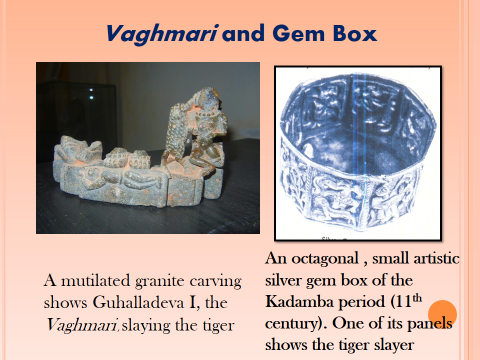
The picture below, shows the enlarged panel on each octagon of the Gem Box (figure 16). The sixth panel is depicting the tiger slayer; the other panels may be showing how the tiger slayer caught the tiger; also the flora and fauna of the Kadamba period are delicately carved on it.
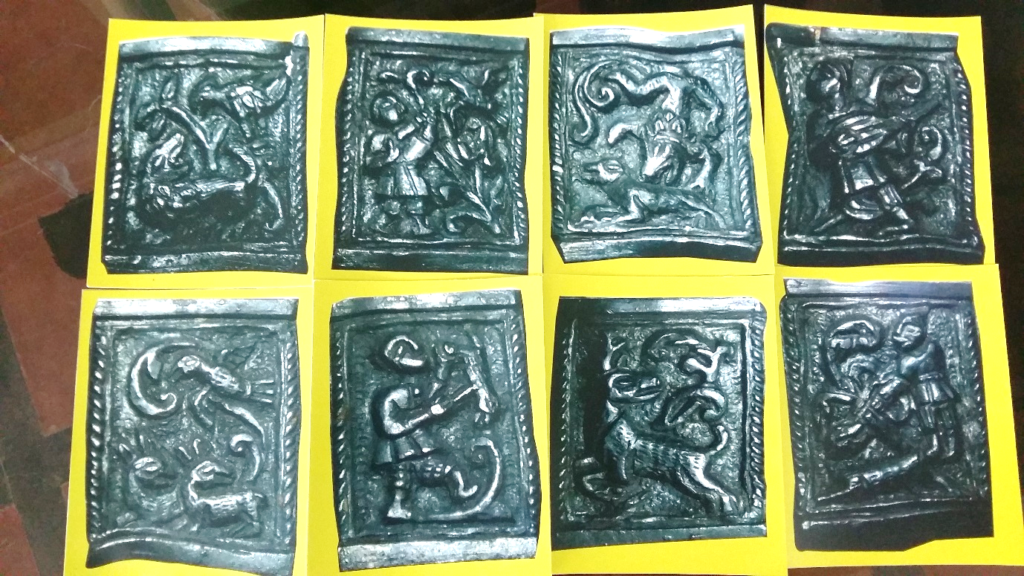
4 CONQUEST OF GOVAPURI
Govapuri was the capital of the Shilaharas from the eight century and Chandrapura was the capital of the Kadambas from the tenth century. In Chapter 4, section 4, the end of the Shilahara rule due to conquest of Govapuri by the Kadambas has been mentioned.
In one of the inscriptions collected b Fr. Heras in 1932, there is an allusion to Kadamba Shasthadeva II who had his capital at Chandrapura. We have seen that there already existed a ship building and repairing station at the Chimbel-Ribandar water front, and being lord of Chandrapura, Shasthadeva II could easily go to Sahyadri Ghats to get plenty of teak wood for building ships. Dr George Moraes in his book “Kadamba Kula” says that Shasthadeva II built a huge fleet of ships and assembled them on the River Aganashini (Zuari) and made his army pass over them to attack and conquer Govapuri. This his feat is compared in the Demgave inscription to the feat of the epic hero Rama in going to rescue his wife Sita from Simhala (Sri Lanka / Ceylon)11. The ships were later used for commercial purposes and that is how many Goans since them took to the profession of sea-farers (tarvotis).
5 TRANSFER OF CAPITAL
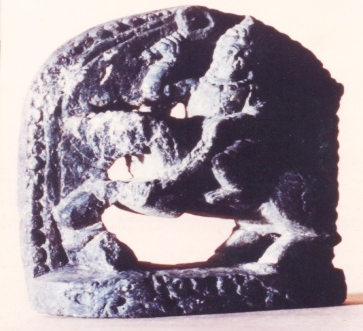
According to the Curtorim copper plate, Viravarmadeva (1042 -1054) had his capital at Gopaka. In 1050, Jayakeshi I, the grandson of Shasthadeva II, transferred definitely his capital to Govapuri, around the Pilar hillock. We have already mentioned the rich Taji merchant Modamod who had helped Shahastadeva II to repair the mast of his ship. When Jayakeshi I ascended the throne of Govapuri, he appointed Saddam, the grandson of Modamod as his Chief Minister. Saddam improved the trade of Govapuri to a great extent.12 A small granite carving, found in a well outside the Pilar compound, shows Jayakeshi I seated on a horse. His Panjim copper plate inscription says that Saddam had established a Mijigithi or Charity house to look after orphans and destitute. It was maintained by a part of the profits of the trade carried through the Gopakapattana port.
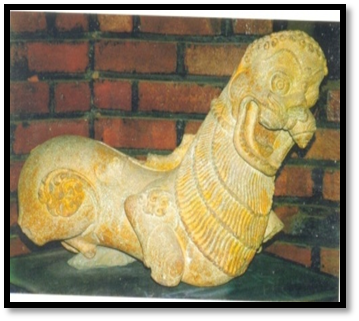
In 1964, while laying foundation of the building for the Fr Agnel High School, Pilar, the beautiful lionemblem of the Kadamba dynasty carved out of sandstone, was unearthed and has a prominent place at the entrance of the Museum. One of its legs though mutilated, is up raised. It is called Simhalanchana (Figure 18(a).
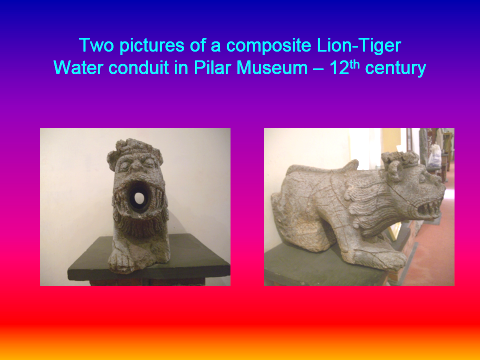
Other items of the period is a composite tiger – lion water conduit: (TEERTHDWAR), its mouth and teeth are of a tiger whereas it has a lion’s mane. It was attached to a fountain. People could drink the water that gushed out of its mouth. It has a special arrangement for those who went to drink water at night to keep the divli (lamp) on its head. It was found buried near a fountain in Pilar.
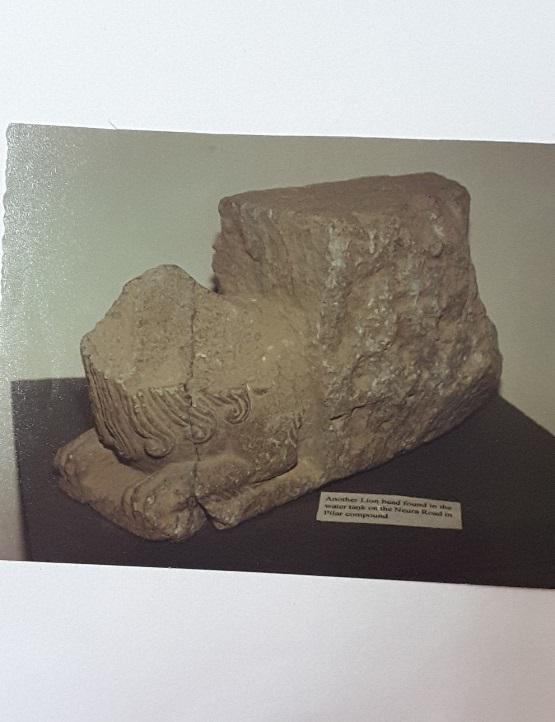
A third sculpture of a mutilated GIRIVYALA / GIRISIMHA representing a lion coming out of a mountain was found in a well while laying the foundation of Fr.Agnel Higher Secondary School, Pilar It was perhaps a decorative object at the entrance of a Kadamba building.
6. RAJBEED or ROYAL HIGHWAY
The boundaries of the capital city of Kadambas, Govapuri, extended from present Agasaim in the South to Karmali in the North, Siridao and Talaulim in the West and to Neura in the East.
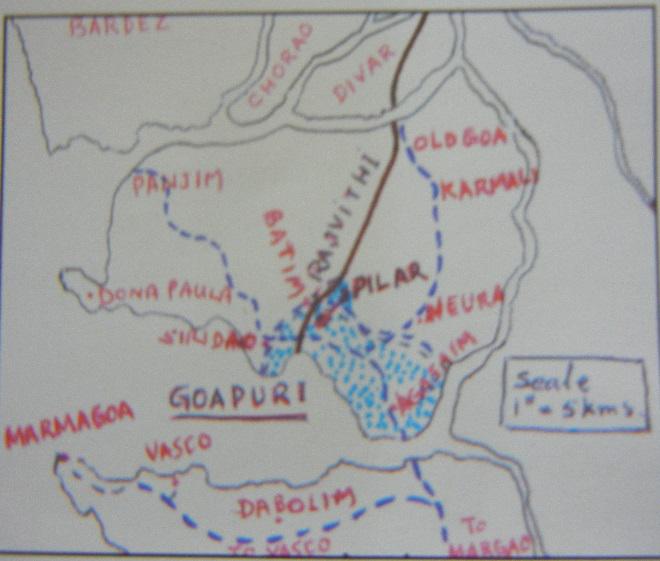
The villages in the outskirts were connected through mountain passes, cast roads and inter-connection of creeks, bunds, dams and canals. They had been constructed for transport, irrigation and protection of lowlands13. The royal road (Rajbeed or Rajjvithi) starts at the Gopakapattana port and then circumvents the Pilar hillock and the present St Anthony’s chapel right up to the hills of Batim, Gaunxim and Moula. Thence it goes over the hills up to Ela (Old Goa) via a hillock (known as Bondo, down St Cajetan’s Church and to the ferry point.
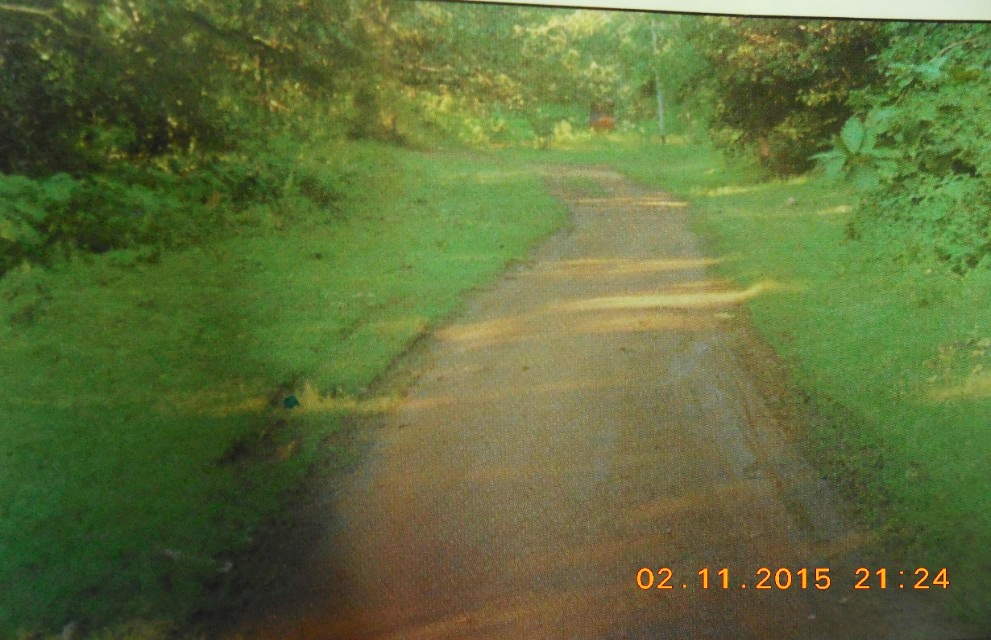
It is further connected across the River Mandovi with Divar, thence goes to Naroa and Bicholim and up the Ghats to Halsi, Banavasi and other parts of Karnataka. It was almost like a modern six-lane highway, only the mid one-third of it is seen here as tarred today. This royal highway that begins at the port, is 60 feet (about 18 metres) broad and about 8 kilometres in length up to the above mentioned hills to Old Goa. At its inception, this highway must have been lined with granite mounds for vendors to sit and sell their wares.

One such mound was found buried deep in a field near the starting point of the highway, and is in the Pilar Museum. It has a line of beautiful and symmetrical lozenges at its upper end, the influence of Hoysaleshwara art of Halebid School.
7 COSMOPOLITAN CITY AND ARTEFACTS
Chandrapura night have been ruled by Jain zealots. However, the capital at Govapuri became a cosmopolitan city, tolerant to all religions. The king was a Hindu, perhaps a descendant of former Jain converts, the Chief Minister was a Muslim. Budsdhist Bikkus (Monks) and Hindu Rishis were carried in palanquins criss-crossing the roads of the city according to the Demgave copperplate of Permadideva. The inscription speaks of the times of Jayakeshi I and says that the poles of the palanquins of the Bikkus and Rishis were covered with jewels and inside them were quivering the golden earings of the owners.14 Besides, there was a Christian settlement on the banks of the River Zuari, as narrated by Ibn Batuta and confirmed by the find of a Sasanian Pahalavi Cross as shown previously in Chapter 3, figure 7(d).
- RELIGIOUS ARTEFACTS
- Snake Cult:
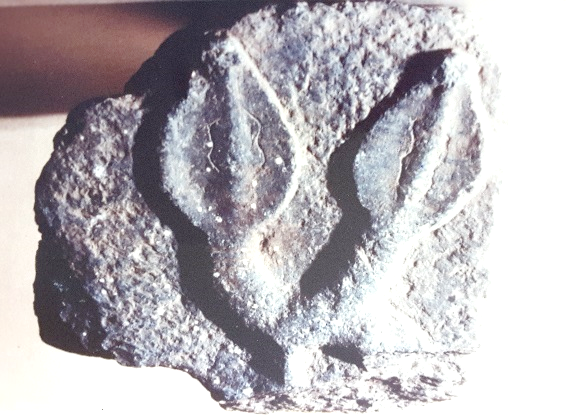
The Hindu Rishis belonged to the Sakta sect and Natha cult and were tantric ritualists. Several Naga stones (Figure 20) were found belonging to the tantrics of the Natha cult in a well, while while laying the foundation stone of the present Fr. Agnel Higher Secondary School and are exposed in the Museum.
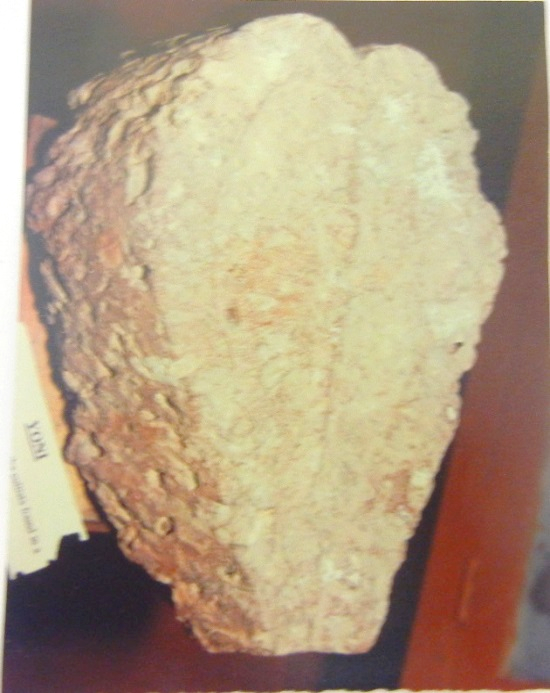
(ii) YONI: A heart shaped Yoni of porous laterite stone, measuring 35 centimetres in length and 24.5 centimeres in width was found in the same well. Its upper portion is provided with a 4cms raised rim. On its center, a small round elevation is carved from which its raised ridge runs to the outlet at its narrow side. According to G. W. Briggs, Kanpatha Yogis acknowledged the practice of Sakta rites. Their Natha sect flourished in the 12th and 13th centuries AD. This also coincides with the zenith of Kadamba power.
(iii) Shiva–Lingam & Vishnu Statues
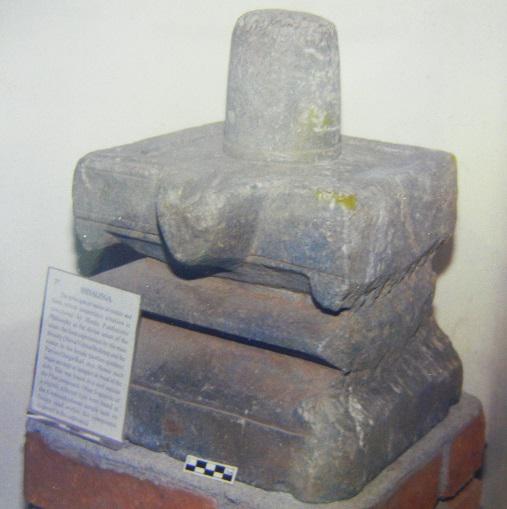

The principle of matter and form which contitutes creation is conceived by Hindu Pantheistic Philosophy as divine union of the sexes: the form represented by the Male divinity (Shiva/ Vishnu/ Brahma) and the matter represented by the Female mother-goddess: Parvati /Kali/ Durga. Hence such lingas are kept in temples in front of the deity. We have a Shiva-Lingam (Figure 22) and other fragments of a slightly different type found in the PIlar tank. Also a statue of Vishnu, found in Benaulim, the upper portion broken in pieces, was gifted to the Pilar Museum. The broken pieces have been fixed in a glass show-case. (Figure 23a). Another head of a Vaishnava deity was also found in the Pilar tank (Figure 23b) The latter could be of the 13th century, which shows that both Shaivism as well as Vaisnavism flourished side by side in the Govapuri city.
(iv) Pretaganas & Kalbharava:
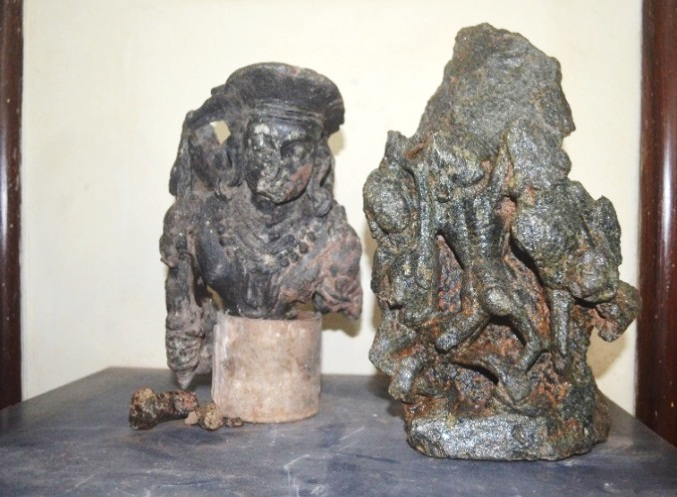
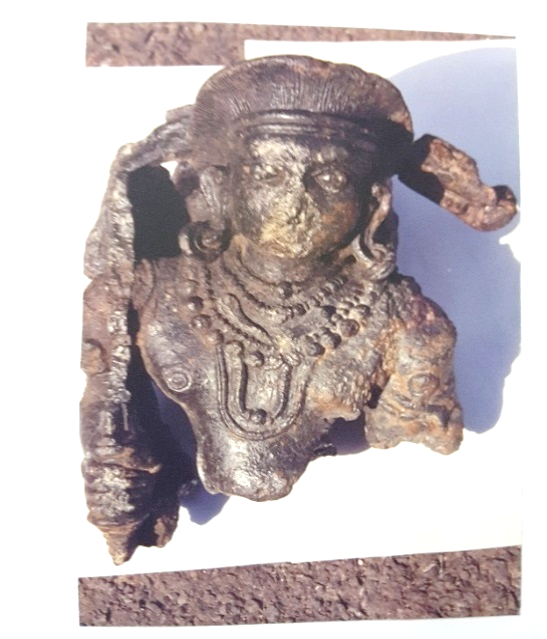
 Pretaganas
Pretaganas
Kalbhairava
A fragment 21cms in breadth and 22.5 cms in height of a very fine and delicate workmanship was found in 1959, near the Fr. Agnel High School at a depth of about one meter. It depicts three dancing emaciated Pretaganas (dancers after death). Without knowledge of X-Rays at that time, the artists of the 11th century AD, who worked on this artefact, seem to have a fair knowledge of the anatony of the human body; as the ribs and bones can be clearly distinguished on the dancers’ bodies. Pretaganas are generally depicted by the side of Kalbhairava, a fierce avatar of Shiva, and is shown alongside ( figure 24). The stone carving of Kalbhairava was found in the Pilar tank later, in 1997.
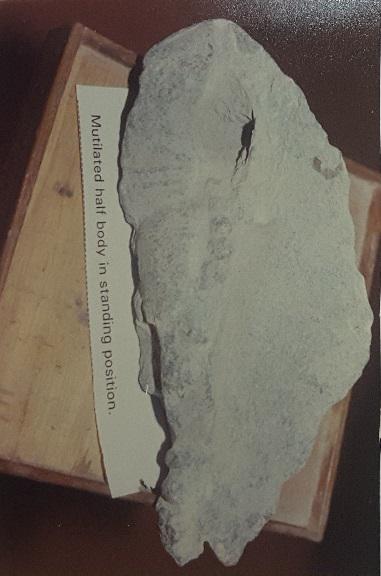
(V) Other palace and temple decorative figurines
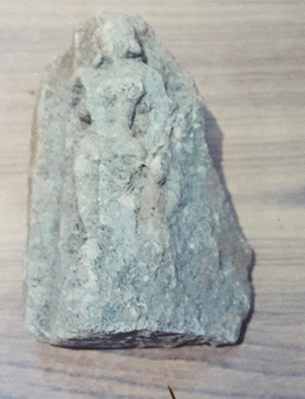
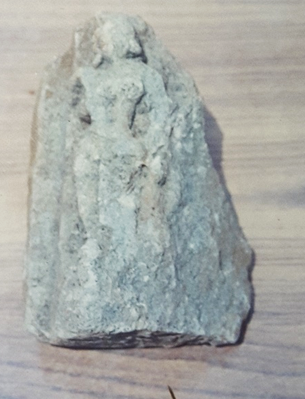 Figure 25 – Chamardharini
Figure 25 – Chamardharini Figure 26-Half human body
Figure 26-Half human body
A small stone carving of Chamardharini, a celestial nymphette or fairy (figure 25), probably part of a Kadamba decorative complex of the 11th or 12th century, was also found in the tank. A broken half human body in standing position could be part of another similar decoration (figure 26)

A headless Nandi bull, generally accompanying the Shivalingam, found outside the Pilar compound was gifted to the Museum (figure 27)
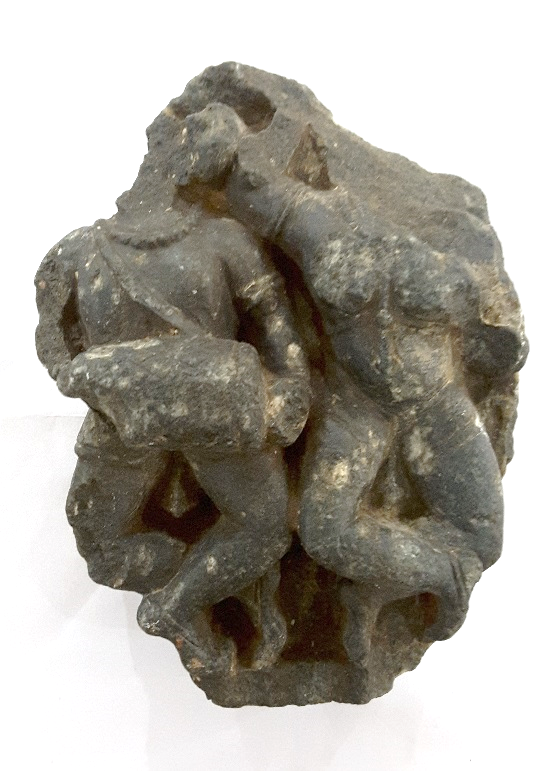
A headless pair of Dancers with Mridang, delicately carvedon a granite stone, found outside the Pilar compound, was also gifted to the Museum (figure 28). It depicts the husband playing the musical instrument while the wife jumps and dances to its tunes.
(vi) A Stone-Cut Cave and a Buddha Pedestal:
Below the present Re-animation Center building on the Pilar hillock, there is a stone cut cave which could be part of a Buddhist Vihara due to its format.The place around the cave is known to the local Hindus as the place of gathering of the Rishis (holy men)
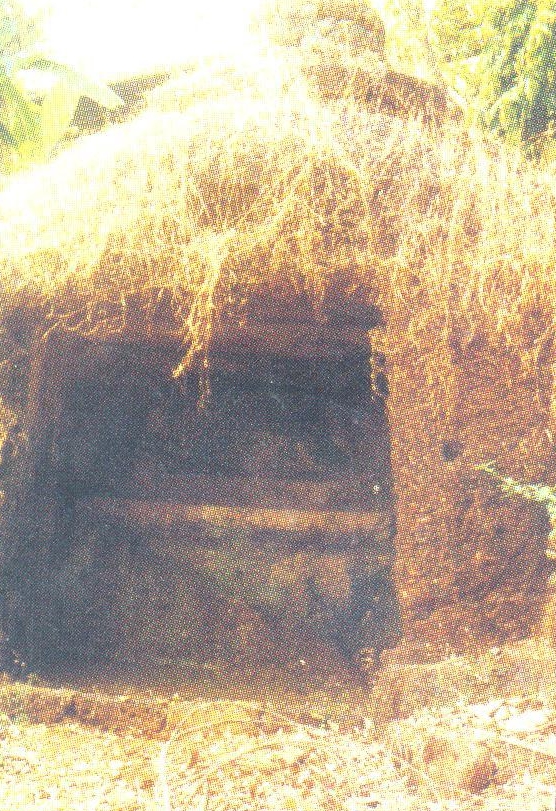
In 1968, in a well with four series of lterite steps leading downwards (behind the present Fr. Agnel Higher Secondary School buinding), the base or pedestal of a laterite statue was discovered. Padma Bhusan, late Dr. Jose Pereira, a Goan scholar specialized in Buddhism, Professor of Theology at Fordham University (USA), deciphered it to be a fragment of a Buddha statue in contemplation. It can still be seen on a Kamlapitha – lotus pedestal (figure29b) with a well-folded dhoti (loin cloth). The statue would be belonging to the Mahayana sect of Buddhism. There was an inscription in Pali language used by the Buddhits in ancient times, a few words of the Pali inscripion, in mutilated form, can still be seen below the feet on the left of the statue.
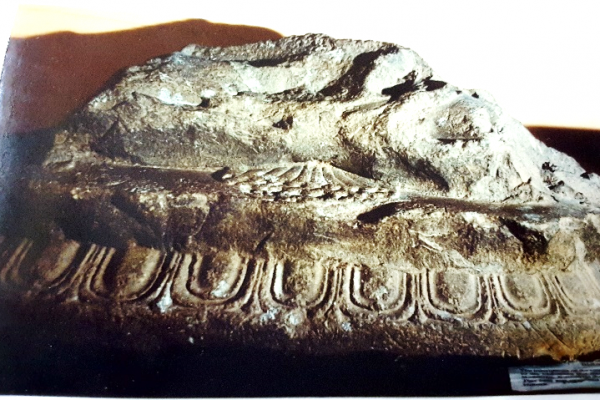
A broken piece of a round granite, probably used by by Buddhist monks as a seat during their meditation (Vipasana) found near by, as well as a bronze Tibetan Buddha and a Buddhist Bell, bought in the Panjim Market from Buddhist refugees by late Mr. C. N. de Sa, Chartered Accountant and offered to the Museum, can also be seen there.
(VII) Hom-Kund
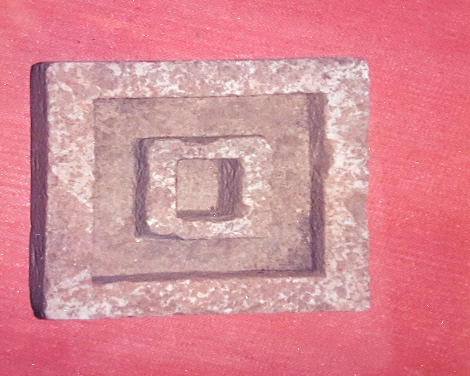
At Hindu religious weddings, after tying the knot, the bride and groom give three rounds around such, while the officaing priest chants the mantras and keeps on feeding the fire. At present such fire places are quite big. However, during Kadamba times it might have been smaller.
(viii) Granite Mouldings

 Figure 30 (a) – Granite stone mouldings of floral designs and leaves
Figure 30 (a) – Granite stone mouldings of floral designs and leaves
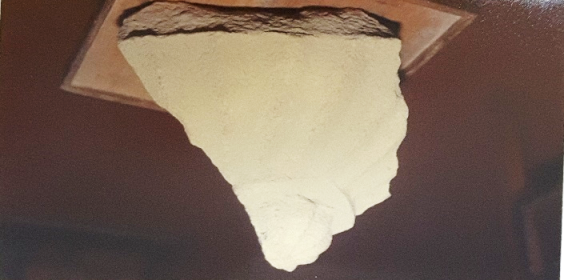
Mouldings on granite stone (figure 30a), found in the Pilar Tank, betray a high degree of sculpturing workmanship. Also a part of around lotus medallion, hanging upside down the roof of the cetral portion (Antarala) perhaps of the Kadamba palace or royal temple (Figure 30b), was found dumped in a well a the foot of the Pilar hillock.
The Upper portion of a Viragal

The upper portion of a Kadamba hero stone , found in a field at Batim was offered to the Pilar Musem by Mr Lawrence Fernandes. It was found by him while digging with an earth-mover (crane) deep into his field in Batim, at a little distance from the Pilar hillock, in 2000 AD. The identity of this hero cannot be deciphered, as the lower portion of this Viragal, which would show the hero’s feats, is missing. He could be a hero who died in any war or fight. It is culminated by the Bhog (bliss) where the hero is shown worshipping the “Linga” with four virgins in waiting, before attaining the peaceful abode of Nirvana (bliss)

(x) Laterite Pillars
As already mentioned in the Introduction of this book, in 1979, the Pilar tank was desilted for the first time, and almost six meters deep centuries olf debris was removed in order to provide water supply, all the year round to the Pilar hillock, which hitherto had been suffering from water shortages from March to beginning of June every year, for its over 300 inmates in the educational institutions, orphanage, hostels and residential units.
At the centre of the tank, there were five octagonal shaped laterite stone pillars. The central pillar, was higher than the others though its upper protion had crumbled. A rectangular portion of an ornamented granite slab, with a square hole in the middle, probably meant to hold the medicinal Tulsi plant (figure 32), was found, fallen down by the side of the middle pillar. While dismantling the pillars to be shifted to the Museum, at the bottom of one of the side pillars, a hole was noticed, in which some ashes were seen which flushed out immediately as they came in contact with water.

(XI) Ornamentations
Different star shaped granite stone ornamentations of Kadamba times testify to the high development of architecture and sculpture from the 11th to 14th centuries; and are comparable to the art of the Hoysaleshwara temples of Halebid. Among them is a portion of a granite doorjamb with carving of half lozenges. .
(xii) Tops and bases of pillars

Several round granite stones were collected from different places on the Pilar hillock and are kept in the Museum. Two pieces of a granite broken pillar were also found separated from one another, by at least 300 metres. When placed over one another, they fitted very well as one single pillar and also when placed between two of the above mentioned round stones, this artefact was deciphered to be a prasad table (Figure 34).
- OBJECTS IN A CAVE
In 1958, prior to the liberation of Goa, there were only 3 buildings on the Pilar hillock – the Monastery, the Seminary and a Pilgrim’s house. It was decided to clean the compound at the foot of the hillock on the western side to put up more buildings for educational institutions and future development. There was an artificial elevated mud mound, causing obstruction, near the spot where at present the entrance of the Fr. Agnel High School building stands. As it was being levelled, a small cave was accidentally noticed.
A German, Dr Gritti Von Mitter-Valner, who studied he objects in the cave, says that it was used by Kanpatha Gosavis (Yogis), of the Natha sect, founded by one Gorakhnath15, already mentioned at the beginning of this Chapter. All objects found in the cave are exhibited in the Pilar Museum:

*A rusted interior of a sword of iron, 34 cms in length: It resembles the Sanskrit Kheteka sword, used in the hoary past (figure 35).

* A Winnowing fan (Srupa) measuring 11.7 x 12 cms cast in metal. It is too small for rice cleaning; it could have been used for ceremonial purposes by the above mentioned Yogis.

*Padukas in the form of sandals placed next to each other on a small platform cast in metal measuring6.6cms in width. The platform stands on 3 small feet the 4th seems to be broken.
Such padukas are generally placed before the deity in places of worship.
.A Small Copper Pot

A very small copper pot 3.5 cms in height and 2.5 cms in diameter at its upper opening was found while deepening a well in the Pilar Compound near the Pilar Tank. It was perhaps used for ceremonial purposes.
- DISCOVERIES BY FR HERAS SJ
In 1932, Fr. Heras sj excavated in the compound of the Pilar Monastery, near the present Fr. Gnel High School and took to his Museum in St Xavier’s College, Mumbai, the folloing artefacts:
A middle sized Nandi (Bull) Two Naga (snake) stones A mutilated head, probably of Shiva A piece of stone lattice window Some gold coins, three of which had the name of Jayakeshi II, inscribed on them16.
D KADAMBA COINS FOUND IN PILAR
A copper coin, 3 cms in diameter, probably of Jayakeshi I with the lion symbol as well as inscription of his name, (but both not clearly legible, as the coin is worn out), was found near the Pilar tank Figure 39). This picture shows the two sides of the coin.
Figure 39 – Both the sides of the Copper coin

One very small gold coin, almost one centimeter in diameter, enlarged in figure 40a, shows the Trishul on one side and the Kadamba Lion emblem on the other. It was found by Mr. Francisco Miranda near the site of the Kadamba palace, (today a private coconut grove), and donated to the Pilar Museum. In Figure 40b, the same gold coin in its real size, and side by side its replica are seen. The latter is a prize won by Mr. Navelkar, retired Librarian of Goa University, at a Goapex philatelic exhibition and donated to the Pilar Museum.

Local tradition says that a Kadamba princess in her rage threw away all her gold and coins, while running away.
- KADAMBA SIGNET RING
Figure 41 – Two views of the same signet ring
A silver ring with a seal was found in the Pilar tank. It is probably a Kadamba officer’s seal (signet) to stamp commercial trasactions of 13th to 14th centuries.
F. BELL HANDLE

A Bell handle topped with a Nandi (bull) of the 14th century, was found buried in a mound outside the Pilar compound. It is made of brass. The bull has a carpeton its back and a necklace embossed but its hump is worn out.
8 LORDS OF THE OCEAN
Jayakeshi I was highly respected by the princes and the lords of the West Coast and always remained at the helm of his powerful fleet. One of his inscriptions says, “He was ever ready with numberless fortified vessels to sail through the seas”.1 In this enterprise his Chief Minister, Saddam, was a great help in building a powerful naval armada.
Gopakapattana had reached its zenith of prosperity due to the well-established cosmopolitan trading port, a powerful protective navy and a system of inland communications2.
- FOREIGN TRADE

A copper plate inscription of Jayakeshi I, said to be presently in Lisbon, says that he had trade relations with distant countries like Simhala (Sri Lanka), Kalah (Kuwait), Zangavar (Zanzibar), Paandya (Tanjore), Kerala, Chouda, Gauda (Bengal), Khyata (Quetta), Gurjara (Gujrat), Khyata (Quetta), Laata, Puxta, Sri Sthanaka (Thana) and Chandrapur3. Only a copy of a copper plate, is reproduced here.

- NAVY
The Navy of the Kadambas was anchored at Velakula harbour, now a khajan land, enclosed by the creeks at Neura in the eastern side of the town on the banks of the River Zuari. This place is now called Velfaly, a corruption of the word Velakula, where the Panjim copper plate confirms that Jayakeshi I had organized a powerful navy in 1053 AD.
The naval commanders and sailors had their quarters at Neura. The name NEURA itself is derived from the word NAV VERAK or URAK, meaning a town of boats (Nav = Boat, Verak = town or shelter). The Navy protected not only Goa but also other parts of the West Coast. Mention must also be made to the quarters of Shenvis or learned Brahmins, who served as royal accountants and writers, probably located at Shenvai-vaddo, today a ward of Neura4. Guhalladeva II (1080 – 1125) is described in the Kadaroli inscription as ”the Great Lord of the best of cities by name Gopakapattana”; Jayakeshi II (1104- 1147) in the Narendra inscription styles himself as Konkan Chakravarti (Ruler of the entire Konkan); Shivachitta Permadideva (1147-1172), proclaimed himself in the Demgave copper plate record as the Paschima –Dakshina Samudradipathi (Lord of the Western and Southern Seas). Another inscription of this period, compares the beauties of the city of Govapuri to the glories of Indra’s paradise.5

The archaeological finds of Pilar, confirm the historical data contained in the above inscriptions and copper plate grants. Bits of foreign and indigenous pottery dating back to the medieval period of Kadamba times, found in the Pilar tank, are exhibited in the Museum.
- Khmer pottery: Pieces of Khmer pottery from Camboj (Thailand) shown in figure 44, date back to the 12th century.
ii Vases with Mica content:

Pieces of vases of later Kadamba period (13th to 14th centuries) shine like gold due to their mica content. Beautiful black pottery in figure 45 and bits of cooking pots in figure 46, having moderate mica content have also been found in Pilar ;

Figure 46 – (right) and Figure 47-(down) with less mica content

iii Royal Palace and Temple Bricks:
Bits of vases, bricks and roof tiles, collected from the tank testify to the rich commercial relations.
A student of archaeology, Ms Alita D’Souza, has made scientific studies of these artefacts and found that the ones shown in figure 48 a & b are made from local clay. The dimensions of the biggest brick is 23 cms x 14 cms x 3 cms.
Figure 48 (a & b) –Bricks and bits of vases made from local clay
Figure 49 – Bigger size pieces of pots
These bigger pieces of black, grey and red pots belonging to the 13th to 14th centuries, were also found at a depth of 12 feet in the Pilar Tank.
- DEVELOPMENT WORKS OF THE KADAMBAS – WATER SUPPLY & IRRIGATION
There are a number of large Water Reservoirs of Kadamba times around the Pilar hillock.
- Batim Tank

Close to the Pilar hillock on the Batim side adjacent to the Kadamba highway, described above, is a large terraced lake in three partitions, (Figure 50a) which was meant to provide water supply all the year round to the city. Probably, if the lower partition of the lake got dry, the water from the middle partition would be made to flow into it with a system of underground regulatory canals as shown in Figure 50b & c). The third or upper partition would be a reservoir for emergency if or when water from both the lower partitions was over.

Distributary canals were supplying water up to Talaulim, Gaunxim and Moula; and at present is still providing water to the vast Khazan field, comprising these three villages, for the purpose of cultivating rice during the dry season (Figure 50b).
Deciphering a copper plate, found with a Keni family of Kunkally, Shri G. H. Khare says that according to it, in the year 1106 AD, A certain Gandogopala Keni of Panjar Khani, who through generations had served the Kadamba rulers, had constructed a tank and installed a Brahmapuri putting up there three houses for Brahmins and a temple.6

Even today a system of stone built canals can be seen, though breached in at several points and therefore not in use. Modern pipes have been placed under the old structure, as shown in figure 50c.
(ii) Neura Tank
There is also another big Reservoir of Water on the Neura Road, outside Pilar Compound, believed to be built by Shivachitta Permadideva (1147-1172 AD). This tank was used for supplying water to the part of Govapuri city extending on the Agasaim side.
The Canal emanating from the tank (reservoir) can still be seen today as shown in figures 50 d and e. It is breached at several points, but still contains water, passing through different wards of the Agasaim village. Today it stretches from Daktem Neura, where the tank is situated, to Agasaim market area, where the canal passes under the old National Highway (NH 17) road and thence it goes beyond up to the wards on the seashore and the port area of Gopakapattana.
By the eastern side of this tank there was a slight elevation in which there were man made caves. According to local tradition some of these caves could have been the abode of Buddhist monks during Kadamba times. Removal of mud for construction of houses in later periods resulted in various old caves being broken or enlarged, and maybe the emergence of new ones.

Figure 50 ((d) – Neura Tank Figure 50 (e) –Water Canal from Daktem Neura to Agasaim village
On the western side of the tank, a ramification of the Rajbid, came from the hills and went to the area of the port. People from Salcete, even in recent times, go on foot to Old Goa using this ramification. Perhaps, near the tank, by the side of this ramification, the Chamundeshwari temple may have been situated, a part of which presently has been covered by the Neura road.
(iii Kuzmorayachem Tollem.

Near the Provedoria (PAP) building in Goa-Velha there is another pond bifurcated by the old Panjim – Agasaim Highway. According to local tradition it was the bathing pond of the Kadamba queens and princesses. It is also believed that before bathing in the pond they would bathe themselves in coconut oil. Coconuts being the principal item of export, the Kadambas had big grinders for extracting coconut oil, attached to their palace, situated just outside the Pilar compound, opposite the present Dhakankar Hospital. Two such grinders are standing today (Figure 50g).

There must have been a wall enclosing the bathing pond for the security of the bathers. The pond is full of silt during the dry season, but contains some water during the rains, and sometimes vegetables are grown in it.
The other part of the pond, in front of the PAP building and beyond it, is filled up and converted into a rice-field. At present a concrete wall has been built by the roadside bordering the pond.

On the next page the Map of South India shows the Kadamba Kingdom at its zenith in Figure 51.
- MEDICAL PROVISION
Several artefacts found in Pilar show that a lot of medical activity went on around the Pilar hillock during Kadamba times. Being the capital city, there were wars and terrific battles, as we have seen in the previous Chapters, and so, naturally thousands would be wounded. The medical practitioners’ pestle (figure 52) was found in the Pilar tank.

It was used by former vaidyas (doctors), to mix medical herbs, juices, leaves and bark pieces of medicinal plants and trees. This pestle was made of quartzite stone and would be used to prepare medicines on a smaller scale in a stone bowl, also found on the Pilar hillock (Figure 52). There are also various smaller bowls and stones in the Pilar Museum, perhaps used for side preparation or grinding of herbs, before being mixed up with the others.

In times of war or emergency when bigger quantity of medicines was needed, a bigger bowl of stone, would be handy, for the purpose (figure 54). Medicines were prepared in the name of the Hindu sun-god, as on the outlet of this bowl, one of the names in Sanskrit “Om Maricha”, of the sun-god, is engraved. Behind the Re-animation Centre, there were some steps going down to the cave shown in figure 29a. One of the steps was this medical bowl, discovered when turned upside down.
The third biggest bowl (figure 55) would be used in greater emergencies or wars for the same purpose. It was found on top of the Pilar hillock behind the Monastery building. Even today, there are some families in the neighbourhood of Pilar, who are experts on bone setting at the time of fractures. They may not have attended any medical college, but perhaps, they are the descendants of the old Vaidyas (doctors), who from father to son, have passed this knowledge of medicinal plants and herbs for generations. They go to the forests and collect the appropriate barks, leaves and herbs and make a pulp and apply it to heal the fractures. It is said that the Kadambas had planted those trees and herbs on the hills surrounding their capital city of Govapuri.
- PATRONAGE TO EDUCATION
In ancient India, a Brahmapuri was an educational institution for secondary type teaching. Primary type exited in village schools in general. The subjects taught in the Brahmapuri included Vedas, Vedangas, astronomy, medicine and some arts and crafts7. The Buddhist called them Viharas.
Tradition holds that there existed a University in Pilar. In figure 29a, the Buddhist cave is described. Section 7 of this Chapter, mentions that the roads of the city were criss-crossed by Hindu Rishis and Buddhist monks. There were many ablution tanks around the Pilar hillock which at some later date were converted into fields. These tanks were perhaps meant for the Acharya (Guru/Teacher) and the Brahmacharis (students), who had to take ritual baths, several times a day.

The Kadamba ruler, Shivachitta Permadideva was married to a Pandyan princess Kamaladevi who became his Maharani (principal Queen). With her husband she established a number of social, cultural and educational institutions throughout the Kingdom. Kamaladevi is said to have played a very important role in the administration and was concerned about the welfare of her subjects8
The Pilar Museum has a sculpture, which was found while deepening a field well outside the compound. It shows a royal couple with hunting instruments. They may have caught a boar (wild pig) and some fowls, which are seen carved on the pedestal. Probably, the sculpture represents the king Shivachitta Permadideva and his queen Kamaladevi (Figure 56).
9. UPS AND DOWNS IN KADAMBA POWER
A JOINT RULE OF TWO BROTHERS
As seen from the beginning of this Chapter, the Kadambas of Goa who had their capital around this Pilar hillock, had a prosperous rule for almost 3 centuries (10th to 12th). But, from the end of the 12th and beginning of the 13th centuries they were caught in the web of ambitions. There was a four-pronged contest for power between the Chalukya Emperors of Kalyani (who were the feudal lords of the Kadambas of Goa), the Yadavas of Devagiri (who were coveting the title of Emperor), the Hoysalas of Halebid and the Kadambas of Goa, for the control over the Deccan.9
It is possible that in those troubled times the two brothers Shivachitta Permadideva (1147-1172) mentioned in the previous subsection and his brother Vishnuchitta Vijayaditya (1147-1185) were ruling together, perhaps one from Govapuri as king, and the other as Yuvaraja from Chandrapura10 before he succeeded him as the king in Govapuri, after the former’s death in 1172 till 1185. The Demgave inscription of Permadideva records that he was ruling from Gopakapuri (another name for Govapuri) and claims to be “Malavari” (Slayer of the Malavas), a tribe in the eastern part of his Kingdom11.
Meanwhile, in 1162 AD, the Chalukya Emperor of Kalyani, Vikramaditya II, ordered Achugi a ruler of Sindh, to subdue the Kadambas of Goa and burn their city: Govapuri.12 Another copper plate corresponding to 1191 AD in the Sanskrit language says that Vikramaditya, Shilahara king of Pahalgad, reinstated a king on the throne of Govapuri, but his name is not mentioned13.
B. SENDREKAS REGAIN ASCENDENCY?
From all these inscriptions, A.R.S. Dhume concludes that the dynasty of the Sendrekas (already mentioned in Chapter 4), who had lost their dominion over Tiswaddi taluka to the Shilaharas and the Kadambas, were constantly trying to regain their power. They might have succeeded with the help of the above ruler of Pahalgad, in their efforts to regain their power for some time after the burning of Govapuri in 1162, as mentioned above; but they might have lost it again, and ruled as sub-feudatories of the Kadambas over parts of Pernem, Divcholi and other talukas, till the end of the Kadamba dynasty14
- INDEPENDENT RULE OF JAYAKESHI III
However, when in 1189, Bhillama, the Yadava ruler of Devagiri, suppressed the Chalukya Emperor Someshwara IV, the latter took shelter with the Goa Kadamba ruler, Jayakeshi III, who had accepted his suzerainty. This Jayakeshi III (1185 – 1211) issued gold coins named “Padmatanka” and engraved on them the words “Shri-Saptakotisha-Labdhavara-Vira-Jayakeshideva”,proclaiming himself a devotee of Saptakoteshwar15, a Shivalinga of seven metals established at the time of Jayakeshi I at Naroa in Tiswaddi taluka16. The gold coins issue leads historians to conjecture that Jayakeshi III had proclaimed his independence from the Chalukyas of Kalyani. The last known date of Jayakeshi III’s reign is 1211 AD17.
D. YADAVA ONSLAUGHT
Meanwhile, Singhana II of the Yadavas of Devagiri (1209-1247) greatly extended his kingdom with the help of Vichanna, a powerful commander of Devagiri forces. They defeated the Shilahara king Bhoja II and conquered Kholapur and reduced to obedience the Rattas of Sundatti. They subdued the Hoysalas and the Pandyas too. Halasige Province was also seized from the Goa Kadambas by them18.
E. SOVIDEVA TRIBHUVANAMALLA
In these troubled times, Jayakeshi III’s son, Sovideva (Soyideva) Tribhuvanamalla came to power in 1216, not in Govapuri, but somewhere else in the Konkan: Dr. V. T. Gune says that two gold coins were found issued in the name of Sovideva Kadamba. According to him, one corresponds to 1218 and the other to 124519; the second reads ‘Shri-Saptakotesha-Rana-Labdhavara-Vira-Sovideva’ since Saptakoteshwar termple was in Tiswaddi, whereas the first coin does not mention the epithet; it means that he was not in control of Tiswaddi in 121620. Then he took control of Govapuri as the MAHAMANDALESHWARA (feudatory) of the Chalukyas of Kalyani. He had a powerful navy and seems to have shortly asserted his independence for a short time. Vichanna then marched the Yadava army against Sovideva and defeated him21. The Yadavas ruled the Kadamba Kingdom for 12 years22.
Around 1238, however, Sovideva was reinstated due to the interference of Mayimdeva Pandit, whose ancestors had prospered under the Goa Kadambas. Mayimdeva, vested with supreme power by the above Singhana II as regards his southern possessions, was personally in charge of the above Halasige province23. But Sovideva again asserted his independence and issued gold coins in 1241 and in 124524. The Majali (Karwar) inscription calls him MAHAAMAHESHWARA (a great King)25. This may have irritated the Yadavas who had already subdued the Chalukyas of Kalyani and contested their title of “Emperor”.
F’ SOVIDEVA’S SLAYING
The Yadavas now expected Sovideva to pay them tribute as their feudatory. They could not relish the fact that Sovideva had already asserted his independence by issuing coins in his own name. The powerful Goa Kadamba Navy was an eye-sore for them. The Yadavas, therefore, again marched their forces against Sovideva in 1246. In the battle that ensued, Sovideva was slain26. The slaying or decapitation of Sovideva can be seen in a big Viragal in the Pilar Museum (figure 57).

This Basalt/Metabasalt Hero Stone – about 1.5 metre in height, 60 cms in width, and 12 cms in thickness – was found buried 10 feet in the ground close to the Pilar hillock. On stylistic ground this is very close to the Viragal displayed in the Old Goa Museum, which can be dated to 13th century AD. It has 4 panels with a top crest. Its lower second panel is divided from the third by a natural defect in the slab, a vein of Quartz (Silica).The lowest panel is heavily worn out and some faint lines are visible which suggest a battle scene; followed by the next panel which presents the cruel slaying of Sovideva with a big and thick chopper (knife or sword); the king’s crowned head is seen fallen on the ground between the feet of his headless body; on the left side of the slayer, stands an armed soldier; the middle panel depicts heavenly nymphs celebrating with a ritualistic dance and drums, Sovideva’s ascendance to Shivaloka (Shiva’s abode). The top panel shows him in heaven, praying before the Linga27.
G. SHASTHADEVA III
Sovideva’s son, Shasthadeva III lived in exile for some time. He had to make efforts to regain the lost position and his brother-in-law, Kamadeva, helped him in coming to the throne by about 124728. This Kamadeva belonged to the above mentioned Rattas of Sundatti.
The Yadavas gradually forced the Kadambas to disband their Navy29. However, to maintain peace, the Yadavas might have imposed, the above mentioned Mayimdeva, as Shathadeva’s Chief Minister30. Peace and order were thus maintained; and Kamadeva too came to rule the portion of North Karnataka of the Kadamba kingdom, which was under Mayimdeva as mentioned before.
The Yadavas, who had fought against and slain Sovideva, would not have made a Viragal (hero stone) to honour him; undoubtedly, this was carved during the reign of his son Shasthadeva III. The Goa plate, whose date corresponds to 1255 AD31, speaks of a donation, made by Shasthadeva III, of a rice field named “Kinjalange” situated to the North of Govapuri, in the village Sulibhatti (its present name is Sulabhatt). Nearby, the above Viragal (Figure 57) was unearthed. Shasthadeva III ruled from Govapuri till 1263/432. After his death the same above mentioned brother-in-law, Kamadeva succeeded him on the throne of Govapuri, Mayimdeva continuing as the Chief Minister. The rule lasted till 1310 AD. After his death, his son succeeded him, but his name is not known.33
H. DEATH – KNELL OF KADAMBAS & YADAVAS
We have seen above that since Jayakeshi I and Saddam had established the powerful Goa Kadamba Navy, it had been the backbone of defence, and protection to trade and commerce of the West Coast of India (which also included the Yadava kingdom). Now that the Kadamba Navy was disbanded by the Yadavas, both the Kadamba as well as the Yadava kingdoms were weakened and their fate was sealed. Both became victims of invasions. Thus, Govapuri, the capital of the Kadambas, as well as Devagiri, the capital of the Yadavas, fell prey to attacks of the Delhi Sultans, as we shall see in Chapter 6.
1 G. M. Moraes, Kadamba Kula,op cit p. 159
2 Ibid. pp. 185-186
3 Dr P Pissurlenkar, O Oriente Portugues, No.22, pp 386-395; also see .S.G. Kadamb, Sources of History of the Kadambas of Goa – Inscriptions, Broadway Publishing House, Panjim, Goa, 2013, pp. 28-51
4 G. M. Moraes, Kadamba Kula, op cit. p. 159
5 Pissurlenkar, Inscricoes pre-portuguesas de Goa, Nova Goa, Oriente Portugues, 1932, pp 383-407
6 G. H. Khare. Sources of History of Medieval Southern India, Vol 4 (Marathi)
7A. R. S. Dhume, op cit. p.281
8 G. M. Moraes, Kadamba Kula, op cit. p 108-110
9 S. G Kadamb, The Kadambas of Goa, Broadway Publishing House, Panjim, Goa, 2010, p 208 -213
10 Pissurlenkar, op. cit. pp383-407
11 Fleet, Dynasties of the Kanarese districts of the Bombay Presidency, Bombay, 1882,pp. 92-93
12 B. D Santoskar, Samaj Rachana ani Samaj Jivan in Gomantak Prakriti ani Sanskriti in Marathii, 1979
13 Shenoy Goimbab (Varde Valaulikar), Marathi article in Kahim Marathi Lekha
14 A. R. S. Dhume op cit. p. 241
15 Fleet,, op cit. p. 276
16 A. R. S. Dhume op cit. p. 241
17 S. G. Kadamb, op cit. p 208-209
18 Fleet, A copper plate grant of Devagiri Yadava king Singhana II, J.B.B.R.A.S, Vol XV, pp 384.
19 V. T. Gune, Goa Gazeteer Part I, 1979 pp 111-113
20 V.T. Gune says that in the first coin there is no mention of the family deity, Shri Sapta Koteshwar, which is in Tiswaddi (Govapuri).
21 G. A. Pereira, An Outline of Pre-Portuguese History of Goa, Diario de Noite Press, Panjim, 1973, p 61
22V T Gune, Goa Gazeteer op cit. p 112
23 S. G. Kadamb, op cit. p 215-217
24 AVN Murthy, The Coins of Karnataka, pp. 126-127
25 S. G. Kadamb. op cit. p 301
26 G M Moraes, Kadamba Kula, Asian Educational services, New Delhi, 1990, p 207; also V.T. Gune op cit. p 111-112 accepts the possibility that Sovideva lost his life
27 Dr A S Gaur, Archaeologist of the National Institute of Oceanography (NIO) and Prof. Dr. Nanda Kumar Kamat of Goa University, saw this Viragal and gave us this explanation of the panels in it.
28 V. T. Gone, Goa Gazetteer op cit. pp. 111-113
29 A.R.S. Dhume, The Cultural History of Goa: 10,000 BC to 1342 AD, MAPP Printers, Panjim, 1985, p 272-273
30 Ibid p. 273
31 G. A. Pereira, op cit. p. 62
32 V T Gune, op cit. p 113. Gune says he ruled up to 1260; S. G. Kadamb, op cit. p 222-223, says up to 1263/4 and even beyond
33 Fleet, Dynasties of Kanarese district, op cit. p. 276
1 A.R.S. Dhume op cit. p. 233-243
2 Ibid pp. 275-276
3 G.M. Moraes, Kadamba Kula, op cit. p. 168
4 A.R.S. Dhume op cit. p.233-234
5 G. M. Moraes, Kadamba Kula, op. cit. pp. 171-172
6 Imperial Gazetteer of India, Vol. XII (Oxford 1908), p. 251, and Epigraphia Indica, Arabic and Persian Supplement p. 39 of 1964-1965.
7 S.G. Kadamb, The Kadambas of Goa, Broadway Publishing House, Panjim 2010, pp. 32-36
8 Ibid pp. 41 – 76
9 Ibid pp. 76-77
10 N.Kamat, Simha and Gajasimha Motif in Goa Kadamba temple Architecture and Numismatics pp. 50-59
11 Epigraphia Indica, Archaeological Survey of India, Calcutta, Vol12, p. 309
12 G.M. Moraes, op cit. pp. 185-186
13 Nandakumar Kamat, Gopakapattan through the Ages pp 254-256
14 Fleet, Inscriptions relating to the Kadamba kings of Goa, JBBRAS IX p.273
15 Gritli von Mitter-Valner,Two natural caves and 11man-made caves of Goa, India pp.504-511
16 Pre-Portuguese remains in Portuguese India, JBHS Vol 4, No 2, pp 20-21, 47-48







